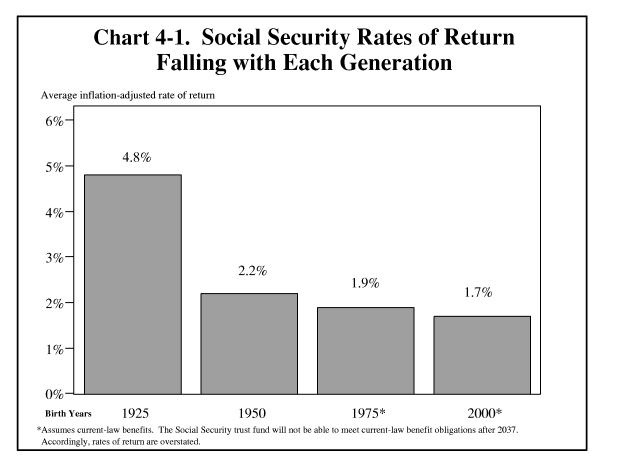
- Afghanistan
- Africa
- Budget Management
- Defense
- Economy
- Education
- Energy
- Environment
- Global Diplomacy
- Health Care
- Homeland Security
- Immigration
- International Trade
- Iraq
- Judicial Nominations
- Middle East
- National Security
- Veterans
- President's Cabinet
- USA Freedom Corps
- Faith-Based & Community Initiatives
- Office of Management and Budget
- National Security Council
- USA.gov
|
Home >
News & Policies >
Policies in Focus >
Social Security
|
Modernize
and Reform Social Security
"We're
going to keep the promise of Social Security and keep the government
from raiding the Social Security surplus. And to safeguard the system
against long-term threats, I will form a Presidential commission
to reform Social Security, and place it on firm financial ground."
For 65 years, Social Security has provided retirement security for tens of millions of Americans. Four generations of Americans have relied on the Government to keep the promises it made to them during their working years. As demographics change and costs increase, the challenge we face is ensuring that the Social Security system is strengthened for tomorrow's retirees. The
Need for Reform First, longer life spans mean more benefit payments. In 1940, during the early years of the program, life expectancy at age 65 was an additional 12 years for men and 13 years for women. By 2075, the remaining life expectancy at age 65 is projected to be 20 years for men and 23 years for women. As a result, people are spending a growing proportion of their lives in retirement. While longer life spans are clearly desirable, they also mean additional years of benefit payments, and a dramatic long-term increase in Government obligations. In addition, a long-term decline in fertility rates means there will be fewer workers available to support each retiree once the baby boom generation starts to retire. As a result of declining birth rates and increasing life expectancy, the ratio of workers to Social Security beneficiaries is expected to shrink from 5.1 in 1960 to 3.4 today to 2.1 in 2030. These demographic trends will strain our ability to make benefit payments at current payroll tax rates. The
Social Security system faces a long-term unfunded liability of
$8.7 trillion. In addition, the structure of Social Security leads
to substantial generational inequities in average rate of return.
(See Chart 4–1.)
Old
Solutions and a New Approach There is a better way to address both the long-term financial crisis and the generational inequities. Allowing individuals to keep some of their payroll taxes in personal retirement accounts to provide for their own retirement security can reduce the need for a rapidly growing Government outlay by creating opportunities for younger workers to enjoy the fruits of higher rates of return in private equity markets. Principles
for Reform The Social Security surplus must be preserved only for Social Security. For 30 years, Social Security surpluses have been used to mask spending increases in programs unrelated to Social Security. Surpluses in the Social Security Trust Funds will total $2.6 trillion over the next 10 years. These surpluses will be saved for Social Security reform and will be used to reduce debt held by the public until Social Security reform is enacted. Social Security payroll taxes must not be increased, as they have been 20 times since the program began in 1937. The Government itself must not invest Social Security funds in the private economy. Successful Social Security reform, which addresses both the long-term unfunded liability and the generational inequities, must be built upon a core of individually controlled, voluntary personal retirement accounts that will augment the Social Security safety net. The
Benefits of Personal Retirement Accounts A balanced portfolio of stocks and bonds can, in the long run, yield almost a 5.5 percent real rate of return. Even a portfolio of inflation-adjusted Government bonds yields a 3.0 percent real rate of return. Both are significantly better investments than those implicit in the current Social Security system, which, for many younger workers, could ultimately result in a negative rate of return. This higher rate of return, through individually controlled investments in private debt and equity markets, is the key to the success of personal accounts. A two to four percentage point differential, compounded over time, means greater retirement security than under current law. The long-term fiscal challenge facing the Social Security system, and the generational inequities inherent in that system, drive the need for reform. Reform is significantly easier to implement if done far in advance, so that individuals and families have time to adjust their retirement plans, and so that changes can be phased in slowly over time. Reform based on personal accounts presents a tremendous new opportunity to enable individuals to build financial wealth and security, while reducing the twin problems of fiscal imbalance and generational inequity. |
||||||||||||||||||||||||||||||||||||


 President George W. Bush meets with the President's Commission to Strengthen Social Security in the Roosevelt Room Jan. 18, 2002. Seated with the President are, from left to right, William Frenzel (far left), Mario Rodriguez, Gwendolyn King, Dr. John Cogan, Commission Co-chair Sen. Patrick Moynihan, Co-chair Richard D. Parsons and Deputy Chief of Staff Josh Bolton.
President George W. Bush meets with the President's Commission to Strengthen Social Security in the Roosevelt Room Jan. 18, 2002. Seated with the President are, from left to right, William Frenzel (far left), Mario Rodriguez, Gwendolyn King, Dr. John Cogan, Commission Co-chair Sen. Patrick Moynihan, Co-chair Richard D. Parsons and Deputy Chief of Staff Josh Bolton.


